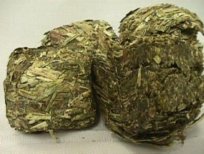Previous Page | Right click this page to print.
Forage Processing
Now we'll talk a little about forage processing. Forages are processed a number of ways depending on the use of the product, the storage available on the farm, and the preference of the farm operator. One of the most common that you are aware of probably is baling hay this is simply tightly tied dried forage wafers that are collected from the field. It increases the density for easier handling of forage as well a little more logical storage in a barn or feed area. Forage can also be chopped and this can be done in the field or at the feeding area and this simply cutting forages into smaller pieces may help aid in mixing with other ingredients such as in total mixed rations and it can improve intake and digestibility of lower quality forages so that animals cannot sort out these particular forages but rather eat them along with the other mixed feeds.
Forages can also be pelleted like grains and grain products this is simply chopping forages and then forcing them through holes to create pellets. These pellets are usually slightly larger than grain pellets, that we talked about before and like in grain pelleting you can incorporate other ingredients for a more complete feed. These pellets will be about the size of a good size cigar and will flake apart very easily.
Cubing is a process much like pelleting, but makes a two by two square pellet. There is a picture on the page that you can see an alfalfa cube and judge it by its size. Forage cubes are easier to handle than baled hay, they can be loaded with a scoop or front-end loader mixed in mixer wagon or bagged and delivered to smaller groups of livestock fairly easily. Cubing hay is fairly expensive and slow it's uncommon to see a lot of cubing done except for export markets where a dense product is important to reduce shipping costs.

Drying or dehydrating forages is used to reduce field losses. We can cut forages in the field, bring in the wet product and then process them through a drying or dehydration oven and reduce the amount of sun loss and wind and so forth that will reduce nutrients in the forages. Most often times when forages are dehydrated they will also be pelleted as part of the process as in dehydrated alfalfa pellets.
Field kernel processing is a newer technique that is used on grain silages primarily corn silage. This is simply a small roller mill, like we have discussed before, that is attached right to the corn harvester as chopped corn is fed in through the machine a roller mill will crush the kernels for better digestibility of starch and then it's carried back to the dairy for preservation.
Previous Page | Right click this page to print.